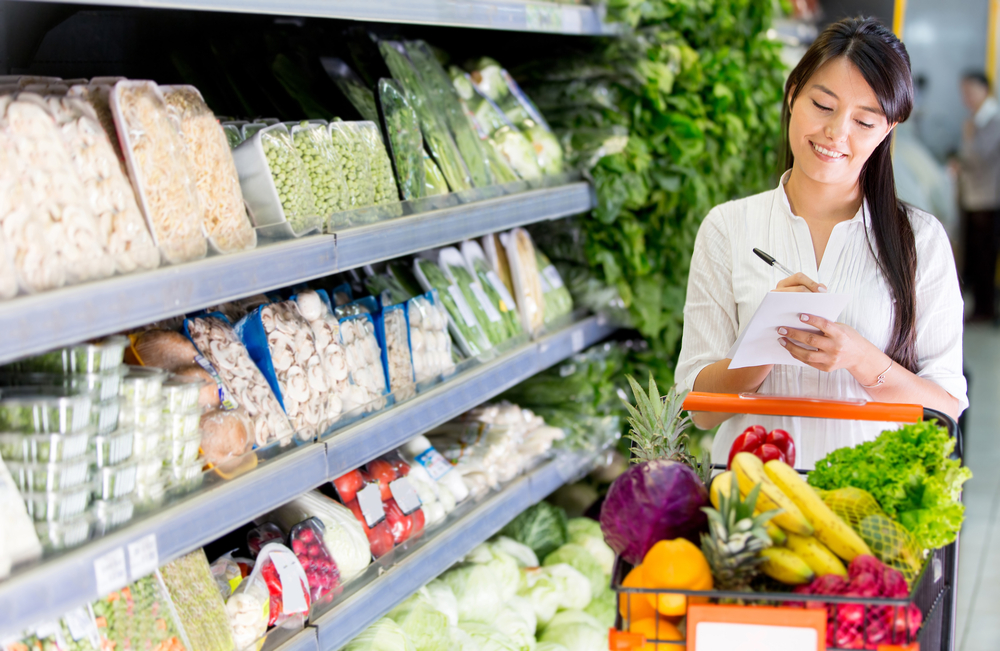
Everyone has to eat, but unfortunately, grocery shopping is also eating up our money. Food is the third most expensive item on most Canadians’ budgets, just under shelter and transportation. And with inflation on the rise, you might find your grocery bill higher than ever.
If you’ve ever wondered how much the average Canadian spends on groceries, it's estimated that we’re spending about 26% more on groceries compared to 2019. For a family of four, that’s $1,227 a month! This figure can also increase for those living in larger cities.
Saving money on groceries is crucial for managing household budgets and promoting financial stability. By reducing your grocery bill, your family can allocate more resources toward savings, debt repayment, or other essential needs - especially if unexpected expenses or financial challenges arise. If you’re wondering how to save money on groceries in Canada, try these practical tips.
Understanding Grocery Budgeting
Establishing a realistic grocery budget is the first step to saving money effectively. To do this, start by assessing your family's average monthly food budget. This can be accomplished by reviewing past receipts or bank statements to identify spending patterns.
Once you have a clear picture of your current costs, set a budget that reflects both your financial capabilities and dietary needs. Consider factors such as household size, dietary restrictions, and any seasonal variations in food prices, especially in regions where local produce can significantly impact costs. A budget planner can help you keep track of everything.
Meal planning plays a crucial role in adhering to your budget and ensuring you make the most of your grocery shopping. By planning your meals for the week ahead, you can create a precise shopping list that avoids impulse purchases and reduces food waste.
Additionally, take advantage of sales and promotions at local stores or farmers' markets to save even more. Keeping an eye on store flyers and using loyalty programs can further enhance your savings while allowing you to enjoy a diverse and nutritious diet.
Smart Grocery Shopping Strategies
Grocery shopping on a budget doesn’t have to be a chore, and it can save a lot of money that can then be put toward your bills or even used to set up an emergency savings fund. Plus, saving money on food doesn’t always mean clipping coupons or poring over grocery store flyers (though that can help)—it just means being smart about grocery shopping. Here are our top grocery shopping tips.
Buying In Bulk vs. Individual Items
Stocking up by buying in bulk is a great way to save money, especially on non-perishable items such as toiletries. It also helps you save on food items, but you need to be careful. You don’t want to buy large quantities of a perishable item and run the risk of it reaching its expiration date before you’ve had a chance to use it.
One option is to ask neighbours, friends, and/or family to do a grocery store run or Costco run together. You can purchase items in bulk that you both need and then split the bill and savings.
|
Grocery Item |
Individual Cost (Sobeys) |
Bulk Cost (Costco) |
|
Whole wheat bread |
$4.49 |
$7.49 per 3-pack (which is $2.49 per loaf) |
|
Chicken breast |
$19.46 per 3-6 pieces |
$30.91 per 7 pieces |
|
Strawberries |
$4.97 per 1 lb |
$5.99 per 2 lbs |
|
Eggs |
$3.88 per 12 eggs |
$10.49 per 30 eggs |
|
Frozen broccoli |
$4.19 for 500 g |
$12.79 for 2 kg |
|
Basmati rice |
$5.29 for 900 g |
$21.99 for 5 kg |
|
Spaghetti |
$3.19 for 900 g |
$11.99 for 4 kg |
|
Ground coffee |
$13.49 for 900g |
$22.99 1.36 kg |
Buy Generic Instead of Name Brands
Many of us stick to familiar brand names, but it can be expensive over time. Let's be honest—generic and store brands don't taste much different. Check their labels and you'll often find the ingredients are the same, sometimes even the exact same product with different packaging.
Seasonal Shopping Benefits
Buying seasonal produce can save you a lot of money. Local farmers’ markets or farm stands often offer seasonal fresh produce at lower prices than grocery stores. Plus, buying local supports the community and is better for the environment.
Don't Shop Hungry
It's a fact: when we're hungry, we buy more. Researchers found that this applies to both food and non-food items. If you go to the Dollar Store hungry, not only are you more likely to overspend on snacks, but also on other items. Before you fill your cart, fill your belly.
Shop at Discount Stores
You may want to go to your favourite supermarket for meats and produce, but shopping at a discount store like Dollarama or Dollar Tree for toiletries, kitchen wares, canned items, and more can save you a bundle versus even the cheapest grocery store. You may even find the same brands for lower prices.
Pay With Cash
It’s easy to buy unnecessary things with credit cards because our only limit is our credit limit, which often doesn't match our actual budget and leads to overspending. Instead, use cash, which makes you more aware of your spending and monthly budget. This awareness helps you consider whether purchases are necessary.
Using Coupons and Loyalty Programs Effectively
Clipping coupons and using loyalty programs can cut down on your grocery bill. However, it's essential to be strategic about which coupons you use and only purchase items already on your shopping list. It's also important to compare prices between different brands or stores to ensure you're getting the best deal.
Loyalty programs offered by grocery stores can also help you save money through discounts, reward points, and personalized offers. By regularly checking for new deals and taking advantage of them, you can see significant savings on your grocery bill.
You can use your smart phone to manage your coupons and loyalty programs best. Most grocery stores have apps you can download and use to shop and clip coupons.
Use Technology for Savings
Online grocery shopping platforms have made it easier than ever to shop efficiently. Many retailers now allow you to order groceries online, where you can take your time to plan meals, compare prices, and avoid impulse buys.
By having a clear view of your shopping list alongside the available deals, you can ensure that you stay within budget. Plus, online shopping can help mitigate the temptation of purchasing items that are on sale but not necessarily needed.
Shopping Apps You Can Use
Price comparison apps allow consumers to quickly evaluate the best deals available across various stores. By scanning barcodes or searching for products, these apps highlight where to find the lowest prices, helping you make informed purchasing decisions without the additional time spent travelling from store to store.
Popular apps like Flipp inform you about current sales and compile digital flyers, making it easier to plan your shopping trip around the best offers. Checkout 51 encourages users to upload their receipts for cashback rewards, making it easy to save on products they’ve already purchased.
Coupons have also transitioned into the digital realm. Many apps offer a straightforward way to access and organize coupons right on your smartphone. Users can browse available coupons, select those that fit their shopping list, and present them at checkout seamlessly.
Here is a financial expert’s guide to couponing without wasting money.
Get Budgeting and Debt Help from Credit Canada
By integrating these approaches into your grocery shopping habits, you can achieve a more manageable budget and better control over your finances. Trying new strategies might feel overwhelming at first, but remember that you don't have to do everything at once.
Start by trying out different stores and seeing what works best. Remember: personal finance is personal, so what works best for your neighbour might not work for you. If you need assistance, Credit Canada is here to help.

Frequently Asked Questions
Have a question? We are here to help.
What is a realistic monthly food budget?
How can I save money on groceries without sacrificing quality?
How can technology aid in grocery budgeting?
How do I calculate my food budget?
To calculate your food budget, start by determining how much you spend on groceries each month. Then, consider factors such as your income, household size, dietary restrictions, and lifestyle choices to determine a realistic budget that works for you.
It may take some trial and error to find the right balance for your needs. Some helpful tips include setting a budget limit per trip or week and planning meals around sales and discounts. Additionally, regularly reviewing and adjusting your budget can help ensure it remains realistic and effective for your situation.
How can I lower my grocery bill in Canada?
There are several ways to lower your grocery bill in Canada, including:
- Shopping at discount stores
- Utilizing coupons, money-saving apps, and loyalty programs
- Buying generic brands instead of name-brands
- Cooking with produce that's in-season
- Buying in bulk
- Meal planning around sales and discounts
- Avoiding impulse buys
For assistance or guidance on managing expenses and staying within budget, consider reaching out to a credit counsellor at Credit Canada.
What are some additional tips for saving on groceries?
Here are some lesser-known tips for saving on groceries:
- Shop at local farmer's markets or stands
- Buy meat in bulk and freeze it for later use
- Use cheaper protein sources such as lentils, beans, and eggs
- Take advantage of student discounts (if applicable)
- Utilize your freezer to store leftovers and extend the life of perishable items. Remember to label them with a date so you can easily keep track.
Remember that even small savings can add up in the long run. Keep experimenting with different strategies until you find what works best for your budget and lifestyle.







